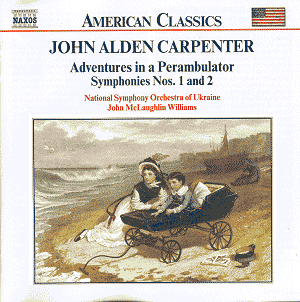John Alden CARPENTER (1876-1951)
Adventures in a Perambulator (1914) [26.51]
Symphony No. 1 (1940) [19.27]
Symphony No. 2 (1942, rev 1947) [19.08]
 National SO of the Ukraine/John
McLaughlin Williams
National SO of the Ukraine/John
McLaughlin Williams
rec 10-16 Dec 1999, Kiev, Ukraine
 NAXOS AMERICAN CLASSICS 8.559065 [65.24]
NAXOS AMERICAN CLASSICS 8.559065 [65.24]
Crotchet
AmazonUK
AmazonUS
Amazon
recommendations

The world is not short of composers who set Whitman or were inspired by him.
Name another composer, apart from Delius, who turned to Sea Drift for
inspiration? John Alden Carpenter wrote an orchestral piece inspired
by the poem. He is also the composer of 'Twenties trendy ballets Krazy
Kat (1921) and Skyscrapers (1923-4). His suite of sophisticated
light music: Adventures in a Perambulator, forms the centre-piece
of this latest disc in the munificent Naxos American Classics series. It
suggests a composer with a Gallic sensibility. In it delicacy and resilience
is mixed with a thoroughly stocked imagination. The suite would manage quite
contentedly without its 'story' which has been supplied by the composer.
Carpenter's highly detailed plotline note is printed in full. Its original
and engaging tone compares well with James Agee's prose poem forming part
of the text to that towering masterpiece of the American heritage, Barber's
Knoxville. Try managing without the note if you can and see what you
make of the suite. Ravel, Rimsky, Strauss and other inventive colourists
are evidently Carpenter's heroes. The most striking movement is The Lake
which could easily partner Goossens' By the Tarn or Vaughan Williams'
much later Prelude to The 49th Parallel. Carpenter' consummate
music-box charm is on display in Dreams in which he stands well clear
of hyper-romanticism - always leaving his textures uncluttered and airy.
He avoids the twee - a hazard which is gleefully embraced by the cover picture
for the CD.
Carpenter prided himself on the peaceful nature of the First Symphony.
Copland ticks and tricks dance in and out of focus as in 00.47 in the
Moderato first movement of the Second Symphony. The composer
is not one for grieving rigour or furious protest though there is anger in
the clamorous opening bars of the 1947 symphony. In both symphonies and
especially the First we hear a composer in the Gallic-American school
of Loeffler, Sowerby, Edward Burlinghame Hill and, in more modern times,
Ned Rorem. These symphonies plumb no giddy emotional depths but they have
the buoyant delicacy of Moeran's Sinfonietta and the Gallic-Hispanic
sizzle of Ravel. Provided you set your expectation sights correctly you will
find new friends here.
Recording, performances and documentation are each admirable. The conductor
is to be watched for the future. It would be a pity if he were to be lost
to Naxos's pioneering series however we must not be surprised if his name
is soon linked to the likes of the Dallas or Minnesota orchestras. I see
that he has already recorded Henry Hadley's Fourth Symphony for a later Naxos
disc. He does not lack adventurous and risk-taking spirit. As a violinist
he has championed such utterly unfashionable repertoire as the Violin Concertos
by Coleridge Taylor (1998 at Harvard), the Bax (Boston) and the Jongen
(Longwood).
A disc well worth adding to your collection - not as a gap filler, which
it certainly is, but as an example of one of the most polished and imaginative
talents at work in 1940s America.
Rob Barnett

